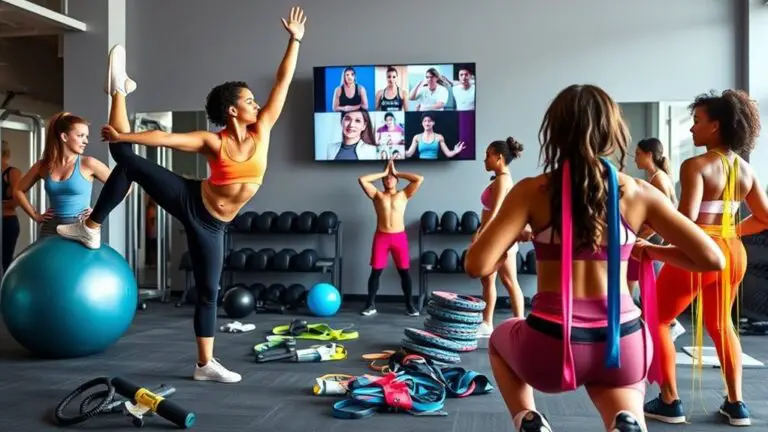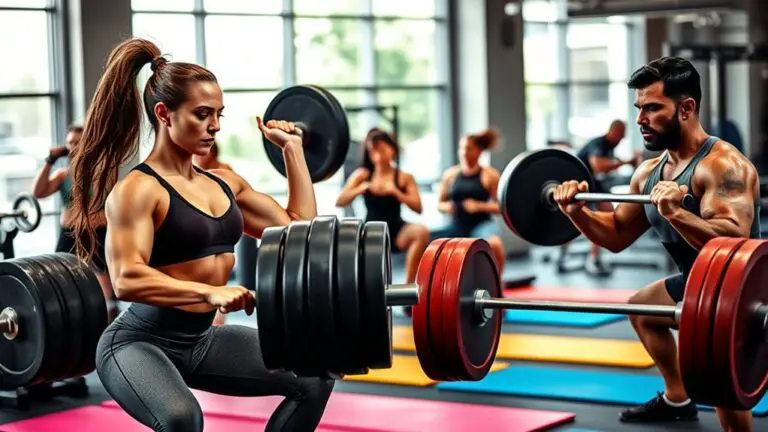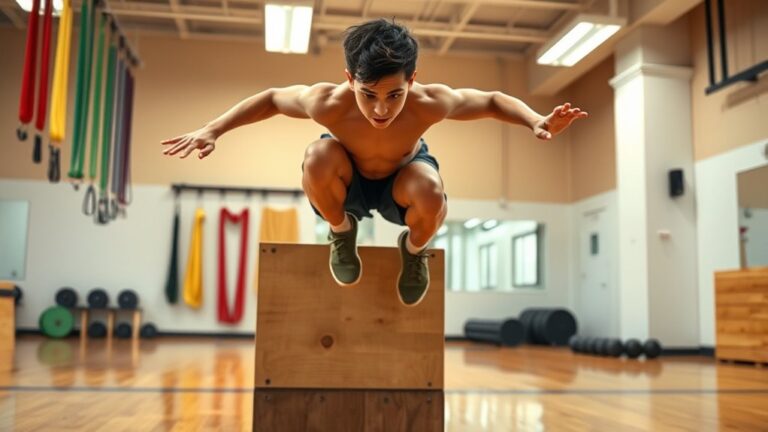The Best Gym Workouts for Kids and Young Athletes
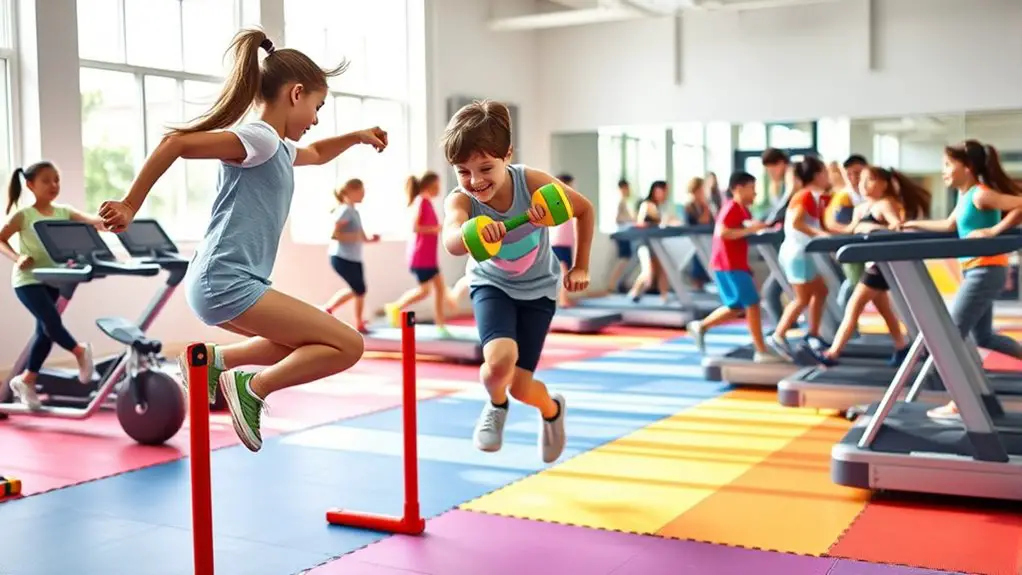
The best gym workouts for kids and young athletes focus on fun, engaging activities that boost strength, coordination, and teamwork. Incorporate cardio workouts like jump rope challenges and dance parties to keep them moving. Bodyweight exercises, like push-ups and squats, are great for building strength. Don’t forget flexibility and mobility exercises to enhance overall performance. By mixing in team sports, you’ll foster camaraderie and friendly competition. Discover more ideas to keep them excited about fitness.
The Importance of Physical Activity for Kids

While it might be easy to overlook, the importance of physical activity for kids can’t be overstated. Engaging in regular exercise is essential for fostering an active lifestyle that promotes both physical and mental well-being. Studies show that children who participate in physical activities are more likely to maintain a healthy weight and avoid the pitfalls of childhood obesity.
Moreover, exercise boosts self-esteem and enhances social skills, as kids often engage in group activities or team sports. By incorporating movement into their daily routine, they develop not just strength and coordination but also lifelong habits that encourage a healthier future. Jump roping is an excellent way for kids to build endurance and coordination while having fun.
It’s imperative to set the stage for kids to be active, whether through organized sports or simply playing outside. Remember, fostering an appreciation for physical activity early on can lead to healthier choices as they grow, making it an essential part of their overall development.
Fun Cardio Workouts to Keep Kids Moving
Keeping kids engaged in cardio can be a fun challenge, and incorporating activities like jump rope challenges or dance party workouts can make it exciting. You might also consider setting up obstacle courses that encourage movement while sparking their competitive spirit. These activities not only promote physical fitness but also enhance coordination and teamwork skills. Additionally, introducing skipping rope exercises can be a great way to improve their cardiovascular health while having fun.
Jump Rope Challenges
Jump rope challenges are not only a fun way to get kids moving, but they also offer a fantastic cardiovascular workout that can improve coordination and agility. By practicing various jump rope techniques, kids can enhance their skills while enjoying friendly competition. You can even organize mini jump rope competitions to motivate them!
Here’s a simple table to get started:
| Challenge | Description | Duration |
|---|---|---|
| Basic Bounce | Standard jumping with both feet | 1 minute |
| Criss-Cross | Cross arms while jumping | 1 minute |
| Single Leg Hops | Jumping on one leg | 30 seconds |
| Double Unders | Jumping twice for each rope swing | 30 seconds |
These challenges keep workouts exciting and help develop endurance!
Dance Party Workouts
Dance party workouts offer a dynamic way for kids to get their heart rates up and stay active, all while having a blast. These fun cardio sessions blend various dance styles with upbeat music playlists, making exercise feel like a celebration. Here are some ideas to kick off your dance party:
- Zumba Kids: Incorporate Latin beats to keep everyone moving.
- Hip-Hop Dance: Use popular songs to energize the atmosphere.
- Just Dance Games: Play video games that encourage dancing and mimic movements.
- Line Dancing: Teach simple routines that everyone can follow easily.
Obstacle Course Fun
After shaking off energy with dance party workouts, another exciting way to keep kids active is through obstacle courses. These courses encourage obstacle creativity, allowing kids to design their own challenges using various equipment like cones, ropes, and mats. Not only do obstacle courses improve physical fitness, but they also enhance agility and coordination.
You can incorporate teamwork challenges by having kids work in pairs or groups to complete the course. This fosters collaboration and communication skills while they cheer each other on. As they navigate through the obstacles, they’ll build confidence and problem-solving abilities. Plus, the fun of racing against the clock adds an extra thrill! Obstacle courses are a fantastic way to keep kids moving and engaged in fitness.
Strength Training Basics for Young Athletes
While it might seem intimidating at first, strength training can be a fun and beneficial activity for young athletes. It’s important to start with a proper strength assessment to guarantee safety and effectiveness. Here are some key strength training basics to keep in mind:
- Focus on Form: Always prioritize proper technique over heavy weights to prevent injuries.
- Use Bodyweight Exercises: Start with resistance techniques like push-ups, squats, and lunges, which are effective for building strength.
- Incorporate Resistance Bands: These can provide a great way to add resistance without the need for heavy weights.
- Progress Gradually: As you get stronger, slowly increase the resistance or complexity of exercises to continue challenging your muscles.
Engaging Team Sports and Group Activities

When it comes to fostering teamwork and social skills, engaging in team sports and group activities can be incredibly beneficial for kids and young athletes. These activities not only promote team bonding but also offer opportunities for skill development in a fun, supportive environment. Participating in sports like soccer, basketball, or volleyball helps children learn how to communicate effectively, solve problems, and work towards common goals.
Research shows that team sports can boost self-esteem and reduce feelings of isolation, making kids feel more connected to their peers. Group activities like relay races or obstacle courses encourage cooperation and friendly competition, enhancing both physical and social skills. Plus, when kids work together, they develop trust and learn to appreciate each other’s strengths. So, whether it’s a weekend league or a school team, getting involved in team sports can greatly enrich your child’s athletic journey and personal growth.
Flexibility and Mobility Exercises for All Ages
Flexibility and mobility exercises play an essential role in maintaining overall physical health for kids and young athletes. These exercises enhance performance, reduce injury risk, and promote better posture. Here are four effective exercises you can incorporate into your routine:
- Dynamic Stretching: Start with movements like leg swings and arm circles to warm up and increase blood flow.
- Hip Openers: Perform lunges with a twist to improve hip flexibility and mobility, vital for various sports.
- Balance Exercises: Try standing on one leg while reaching for the opposite foot, which enhances stability and coordination.
- Foam Rolling: Use a foam roller to release muscle tension and improve flexibility in key areas like the back and legs.
Incorporating Games Into Workout Routines
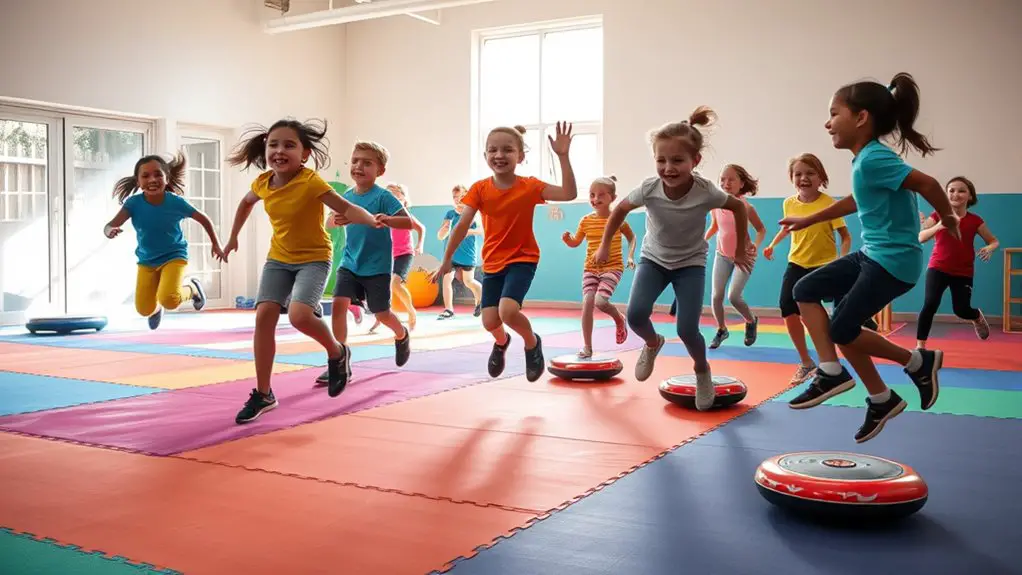
Incorporating games into workout routines can make exercise more enjoyable for kids and young athletes. Fun circuit challenges, relay races, and interactive fitness games not only boost motivation but also improve physical skills. By framing workouts as play, you’re likely to see increased participation and enthusiasm.
Fun Circuit Challenges
While staying active is essential for kids and young athletes, making workouts feel like play can greatly boost their enthusiasm and commitment. Fun circuit challenges incorporate games into workout routines, promoting both fitness and enjoyment through circuit creativity. Here are some challenge variations you can try:
- Obstacle Course: Set up cones, hurdles, and tunnels for kids to navigate.
- Balloon Keep-Up: Incorporate balloons in a circuit, aiming to keep them in the air while performing exercises.
- Animal Movements: Have kids mimic animal movements (like frog jumps or bear crawls) in a circuit format.
- Team Relay Stations: Create stations where teams compete to complete workouts, adding a fun competitive edge.
These variations make fitness engaging, ensuring kids look forward to their workouts!
Relay Races Benefits
Relay races are an exciting way to blend teamwork and fitness while keeping kids engaged in their workout routines. They foster essential skills like communication and collaboration, helping young athletes learn effective relay race strategies. Not only do these races improve speed and coordination, but they also reinforce the importance of working together toward a common goal.
| Teamwork Benefits | Relay Race Strategies |
|---|---|
| Builds trust among teammates | Assign roles for efficiency |
| Enhances communication skills | Practice baton passing techniques |
| Encourages healthy competition | Set time goals for improvement |
Interactive Fitness Games
Interactive fitness games are a fantastic way to make workouts more enjoyable for kids and young athletes. By incorporating fun elements, you can keep them engaged and active. Here are some ideas to get started:
- Virtual Fitness Challenges: Use apps or online platforms to set fitness goals and track progress.
- Obstacle Courses: Create a series of fun tasks that promote agility and coordination.
- Team-Based Games: Organize friendly competitions, like relays or tug-of-war, to build teamwork and camaraderie.
- Dance Workouts: Incorporate dance routines that combine exercise with rhythm and movement.
These interactive challenges not only help improve fitness but also foster social connections, making workouts something kids look forward to!
Setting Goals and Tracking Progress in Fitness
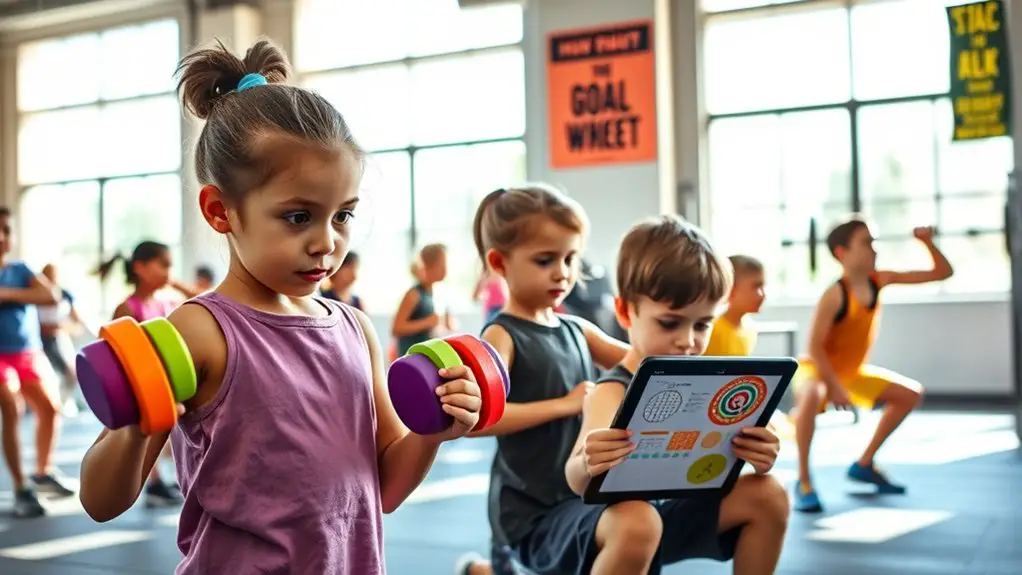
Setting goals in fitness is like charting a course for a journey; it gives kids and young athletes a clear direction and purpose. By engaging in goal setting, you can create achievable targets that motivate you to improve. Progress tracking is essential to see how far you’ve come, keeping your enthusiasm high.
Here’s a simple way to set and track your goals:
| Goal Type | Example |
|---|---|
| Strength | Lift 10% more weight |
| Endurance | Run a mile in under 8 mins |
| Flexibility | Touch toes without bending |
| Skill Development | Improve dribbling speed |
| Overall Fitness | Attend workouts 3 times/week |
Regularly checking in on your goals and adjusting them as needed helps maintain focus. Celebrate small victories along the way; it reinforces your commitment and boosts confidence in your fitness journey!
Frequently Asked Questions
What Age Is Appropriate to Start Gym Workouts for Kids?
When considering what age’s appropriate to start gym workouts for kids, age guidelines suggest that children as young as 7 can engage in structured activities. At this age, fitness benefits like improved strength, coordination, and social skills become evident. It’s important to focus on fun and proper techniques rather than heavy lifting. By cultivating a positive environment, you’ll help instill a lifelong love for fitness, setting the stage for healthy habits.
How Often Should Kids Work Out Each Week?
When considering how often kids should work out each week, aim for fitness frequency of at least three to five days. This allows for a mix of cardio, strength, and flexibility exercises, ensuring workout variety. Evidence suggests that regular physical activity supports growth, development, and overall health. It’s also important to listen to their bodies and adjust accordingly, promoting a positive attitude towards fitness that can last a lifetime.
Are There Specific Exercises to Avoid for Young Athletes?
You wouldn’t want your young athlete to leap into a lion’s den of risky exercises! For injury prevention, steer clear of high-impact activities like heavy weightlifting or high-intensity plyometrics. Instead, focus on exercise modifications that promote strength and flexibility without the peril. Simple bodyweight exercises, like squats or push-ups, are great alternatives. Remember, it’s all about building a solid foundation while keeping their bodies safe and ready for action!
How Can Parents Encourage Kids to Stay Active?
To encourage your kids to stay active, focus on incorporating active play into their daily routines. Plan family involvement in fun activities like biking, hiking, or playing sports together. Research shows that kids are more likely to be active when their parents participate. Create a schedule that includes regular active play sessions, making it a fun bonding experience. By fostering a positive environment, you’ll help instill a lifelong appreciation for physical activity in your children.
What Should Kids Eat Before and After Workouts?
Imagine your body as a car: it needs the right fuel to run smoothly. Before workouts, think of pre-workout snacks like bananas or yogurt, giving you the energy to hit the road. After the race, post-workout meals like grilled chicken with veggies help repair your engine. Balancing carbs and protein guarantees you recover well, keeping you revved up for the next adventure. Fuel smart, and you’ll zoom past the finish line!



